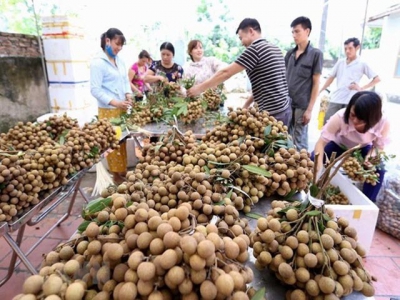Vietnam focuses on fruit exports for higher value

Hanoi - Vietnamese agriculture officials made fruits a key export product as it can bring eight or nine times more in value compare to rice production.
The Ministry of Agriculture and Rural Development (MARD) this year added fruits to its list of key export agricultural products along with seafood, rice, cashew nut, timber, furniture, coffee, rubber and pepper.
"Demand for fruits and vegetables on the world market increases by 3.6 percent every year,” a representative of MARD said.
“There is a big chance for Vietnam to develop its fruit products to the world market,” he added.
Currently, Vietnamese fruits are exported to 60 countries. Fruit export turnover hit 3.5 billion USD in 2017 and is projected at 3.6 billion USD this year. According to the Food and Agriculture Organization of the United Nations (FAO), the world's market for vegetable and fruit has a growth rate of nearly 2.9 percent in 2016-2021.
Vietnam’s vegetable and fruit export value currently accounts for less than 1 percent of the global vegetable and fruit revenue, which shows the great potential of this sector that still has more room to develop.
"Spanning as much as 40 percent of the rice planting area, vegetable and fruit growing areas bring export revenue much bigger than that of rice in Vietnam," said Minister of Agriculture and Rural Development Nguyen Xuan Cuong earlier this year.
In the first seven months of 2019, the country exported more than four million tonnes of rice worth 1.73 billion USD, 14.3 percent lower in value from the same period last year.
Cuong told local media the world's average global trade in rice is only about 35-36 billion USD per year while the value of fruits was 240 billion USD. With an average growth rate of 2-3 percent in the next five years, fruit production could create profit eight or nine times higher than rice, he added.
Focus on fruit hub in the south
According to Department of Crop Production, the south of Vietnam has the biggest fruit planting area of 600,000ha and total productivity 6.6 million tonnes, accounting for 67 percent of production nationwide.
Common fruits in the region are mango, banana, dragon fruit, durian, orange, grapefruit, longan, pineapple, rambutan, jackfruit, avocado and passion fruit.
Along with potential, MARD also sees challenge in cultivation. Currently, the region's fruit farming is small scale, with a lack of processed fruit and low adoption of international plantation standards.
Dang Phuc Nguyen, General Secretary of Vietnam Fruit and Vegetable Association, said as the fruit production hub of the south, fruit farmers in the Mekong Delta work separately, making it difficult for them to use machinery to boost production.
To change this, Nguyen said MARD’s development plans aim to transform 500,000ha of rice growing land to either fruit growing or aquaculture production.
The ministry also pointed out only 10 percent of production area there is used for high quality products that meet Global Good Agriculture Practices (GlobalGAP) certificates, the international standard for exports to the demanding markets of Europe, the US, Japan and South Korea.
To improve the situation, MARD has urged local departments to encourage farmers to apply international standards to their plantations.
Nguyen Quoc Toan, Director of the Agricultural Products Processing and Development Department, said that product branding was also an important issue.
Currently, only two products have national brands, rice and tea, so Vietnamese fruit products also need to get national brands soon.
To achieve this, the fruit and vegetable industry should pay attention to requirements of export markets, traceability, labels and packaging. In particular, it should pay attention to processed goods and increase enterprises’ processing ability, as exporting fresh fruits face technical barriers while processed fruit products do not. Besides, processed products have higher added value.
Related news
 Vietnam’s pepper sector targets sustainable development
Vietnam’s pepper sector targets sustainable development Vietnam’s pepper sector is facing a range of difficulties due to the oversupply and the fierce competition in the global market, resulting in low prices
 Gene variation study offers livestock breeding program insight
Gene variation study offers livestock breeding program insight Novel analysis gives insights into how gene activity can help explain how genetic differences inherited from each parent influence important traits in livestock
 Production of fatty acid, protein by Nannochloropsis in flat-plate photobioreactors
Production of fatty acid, protein by Nannochloropsis in flat-plate photobioreactors Replacing aquafeed ingredients with single-cell oils and proteins from microalgae could reduce the environmental impacts of aquaculture